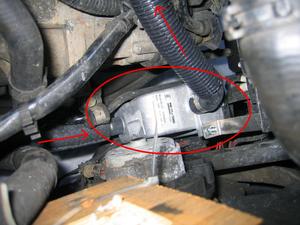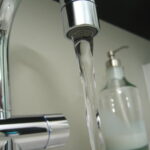3:00 AM – AT HOME
It’s nighttime. I’ve been asleep for a few hours already. Chico the Parrot abandoned his cage this evening: he flew down onto the floor, walked down the long hallway, and crawled up the bed sheets to park on my arm for an evening preening.
A little while later the smart little guy crawls up somewhere between the covers I piled on top of the bed. Just how the little guy manages not to get squashed in the night is a mystery to me. He figured that out two years ago. Anyway, he keeps warm by freeloading off of my body heat, and somehow navigates his way between these two blankets as I shift around throughout the night.
In a few minutes he drifts off into a deep avian slumber.
EIGHT MINUTES LATER
In another room in my home, a switch silently closes a circuit which electrifies an extension cord leading outside my home. The power meter on the side of my house begins to turn a little faster…
THREE HOURS LATER
Soon the alarm clock will ring, but I’m still confidently snoozing. Chico crawls down somewhere near my feet to escape the horrifying bear-like drone of my snoring.
Otherwise, these two unlikely bachelor-roommates are warm and cozy.
But now, so is my car.
WARM & COZY CAR?
I own a VW diesel Jetta. Best dang car I ever bought. I make my own biodiesel and run my car with that. I even figured out a way to run it on biodiesel without buying a conversion kit.
But whether I’m running the car on veggie oil or regular diesel, diesel-engine cars can be hard to start in severe cold. Given the colder-than-normal weather this winter, I would normally have a tougher time starting the car – if it wasn’t for the engine block heater I installed.
My car is indeed warm and cozy.
After I trek to the car, I unplug the power extension from the front of the car (see IMAGE) and tuck the car-end of the cord up into the bottom radiator grill. Safely inside the car’s chilly passenger cabin, I turn the key. The engine fires up immediately, and in a few seconds I drive off into the cold with a warm engine and warm air blowing into the cabin.
A half hour later the timer switch at home shuts off.
ENGINE BLOCK HEATER
A “block heater” is a device that keeps your car’s engine warm in cold weather.
The “block” part of this terminology refers to the massive block of metal from which your car’s engine has been crafted. This massive chunk of metal cools off rapidly in cold weather when your engine isn’t running. Cold weather conditions present special problems both to the car itself and the person operating it.
An engine block heater eliminates – or at least – alleviates some of these problems.
BENEFITS OF A BLOCK HEATER
Why keep it warm? Whether your car burns regular gasoline, diesel, or even biodiesel, there are several benefits to using a block heater. These benefits include:
* Reduces Cold Engine Stress – Even though you can frequently start a car and drive off with a cold engine, the time your car is operating under load with the engine still cold is very stressful to the engine. As we know, metal engine parts expand when the car heats up, and some cars are sensitive to whether they are operated at their nominal operating temperature. Parts that have not heated up and expanded to their correct size might become damaged during cold operation. With as many parts as there are in a car, this many unexpanded parts operating adjacent to one another can have a cumulative effect, and over time can add up to engine damage. By pre-heating your car’s engine, you can eliminate or reduce this impending damage.
* Cabin Air Warms Up Sooner – Because your car’s cabin air is heated by your engine’s coolant fluid, you can draw warm cabin air almost immediately from an engine that has been preheated by a block heater. This is sheer comfort on a chilly morning.
KINDS OF BLOCK HEATERS
So, what kind of block heaters are there? Basically there are two: external and internal.
EXTERNAL BLOCK HEATERS
Some block heaters require no installation or permanent attachment to your engine, of which there are several common kinds.
* Flood Lamp or Shop Lamps: This is perhaps the cheapest and most economical form of an engine heater. Because these lamps get pretty hot, and some are made with a narrow profile, you can fit them under your hood and rest them directly next to your engine. Try putting a thick blanket over the top of your cold engine at night, and lower the hood so it’s closed almost all the way. Keep the blanket from direct contact with the heat source. Do this and you may have a pretty warm engine in the morning.
Pros: Cheap, low-tech.
Cons: Maybe not hot enough to make a difference. Doesn’t work worth a hoot in the wind.
* Space Heaters: These are electric room heaters (not to be used outdoors), also known as a space heater. I know of some folks who put these in front of their car’s engine while it’s parked in the garage.
Pros: Readily available.
Cons: While it helps to keep the front end of their car warm, most of the heat misses the engine itself – kind of useless and inefficient. Can’t use one outdoors (or at least shouldn’t).
* Forced-Air (Kerosene) Heaters: Another outside heater is a kerosene-fired forced-air heater – the kind farmers and mechanics use to heat up garages and barns. While using this for older all-metal cars is okay, more modern cars (like my Jetta) made with plastic body parts and front grills may get their paint scorched or suffer some melt-down.
Pros: Big, blasting, generous warmth.
Cons: Unless you have a truck bed in which to tote this baby around, you have to leave it at home after you leave. Danger of suffocation in small areas with limited ventilation. Doesn’t work worth a hoot outdoors in the wind.
* Magnetic External Heaters: These external heaters use magnets to attach themselves to your engine block’s outer jacket.
Pros: Small, cheap, can easily be applied and removed.
Cons: Some engine blocks are irregularly shaped or are surrounded by mechanical gizmos. These impediments may keep you from having access to a flat surface upon which you can attach the flat surface of the heater to your engine. Thus, no heat transfer. Also, these puppies only put out a couple hundred watts at most – not much to make a noticeable difference in pre-heating your engine. Don’t drive off with one still attached to your car. It will either melt or fall onto a critical part – like a belt – possibly damaging the engine.
* Warm Room: Nothing beats keeping your car in a warm garage or other warmer room to help speed engine warm-up before you drive off. Most folks I know don’t pamper their cars this way.
Pros: Easy, available.
Cons: Garage only. Could be expensive since you’re heating an entire room instead of just the car engine. Not very green either!
* Glowing Coals & Wood Embers: I’ve heard about this, and I’ve also heard about how this dangerous heating method can go awry. (BOOM!) Don’t even try it!
INTERNAL BLOCK HEATERS
This variety of block heater performs better overall, as it applies heat somewhere into the engine itself – exactly where you want it to go.
Oil Dipstick Heater: This functions like a regular dipstick in that it goes directly down into the oil in your car’s oil pan. The dipper end of the dipstick contains an electrified element that applies heat directly to your engine’s oil.
Pros: Cheap. No installation – just plug it in and go.
Cons: Not recommended for cars with plastic dipstick tubes, as these can melt. Because the dipper applies such intense heat in such a small surface area, some claim a dipper heater may actually burn your engine oil – which in turn may lead to engine damage. Also, with such a small area being heated, it truly does not warm your engine block. At the most, it makes some of your oil warm, but this oil will quickly return to near-freezing temperatures when circulated into your cold engine on startup. What heat a dipstick heater provides is almost negligible.
Heated Oil Drain Plug: This usually runs off of 12-volt car current. It contains an electrified heating element (similar to the one in the heated dipstick) inside the plug.
Pros: Easy to install.
Cons: Can only install when changing the oil. These are getting harder to find (VW used to make them for my car), I guess because they really do such a poor job from what I hear. These bear drawbacks quite similar to the dipstick heater mentioned above.
Oil Pan Pad Heater: This runs off of regular 110 volt house current, or sometimes 12-24 volt auto current. Peel off an adhesive backing and stick it onto the bottom of your oil pan. Maybe add some glue and it’s good to stay.This is a decent step up from the oil dipstick and drain plug heaters as they can really lay on some juice.
Pros: Easy to install.
Cons: Again, at the most it makes your oil warm. And this oil will quickly return to near-freezing temperatures when circulated into your cold engine on startup. What heat it does transfer frequently goes unnoticed.
THE BEST
I saved the vey best for last. This one is an internal-style block heater.
Coolant-Water Block Heater: This runs off of regular 110 volt house current, and it applies powerful electric heat directly to your engine’s coolant water system. If properly installed, it will continuously flow through your engine’s water jacket through natural convection. Top-end models include a thermostat which shuts off the heat upon your engine’s arrival at a certain temperature.
Pros: By far the best there is, just short of actually turning on the engine and letting it heat up.
Cons: Some are hard to install by oneself. May require a mechanic’s skills.
ON MY CAR…
I use a coolant-water style heater modified especially for Volkswagen TDI cars, an made with a stock heart core manufactured by a company called FrostHeater. As I mentioned before, my car has a diesel engine, which can be a little hard to start if not pre-warmed. By pre-warming my car’s engine with a block heater, it fires up without hesitation and produces ample cabin within a minute or two after starting – compared to upwards of 15 minutes after starting on a really cold morning.
As a plus on my TDI, my heater heats the water directly adjacent to the water-oil heat exchanger, thus in turn it actually heats up some of the engine oil, too. Not bad for a gizmo designed to heat only one vital fluid.
USE A TIMER
To keep from running up a huge power bill, I use an appliance timer set to start heating my engine about 3-4 hours before I need to fire up. On cold and really windy nights, all this heat could easily get blown away. In this case I leave the heat plugged in all night. See the accompanying IMAGE of the timer switch, which you can buy in hardware stores. If you buy one, be sure it is made for heavy duty use.
BE SAFE, DRIVE WARM!
With all this warm coziness about me, I can concentrate on how badly those other shivering drivers fare on the road.
Unfortunately Mr. Chico cannot come with me to most of my customer’s work sites. But he’s okay. His perch is electrically heated, too!
Have fun!
– John
To email me: click here
To read other cool articles: click here
Bookmark these articles conveniently from one page by Clicking Here.
You may also subscribe to these by clicking the “Subscribe” button.
Legal stuff: Disclaimer & Safety Notice: Author does not warrant or assume any legal liability or responsibility for the accuracy, safety, completeness, or usefulness of any information, apparatus, product, or process disclosed or referred to. Information is provided for informational purposes only. Any actions taken on the reader’s part are taken entirely at the reader’s own risk. Author shall not be liable for any errors in the content, or for any actions taken in reliance thereon. Furthermore, Author shall not be liable for any loss of profits, contracts, opportunities or any direct, indirect or consequential loss of any kind (including death and/or injury), business interruption or loss of property arising out of or in connection with the use of the information herein. News items and any statements posed by author are based on rumor and should be considered also as rumor. So there.
© 2008 John Melendez – All rights reserved worldwide. Duplication in part or in full is prohibited. Violators will be prosecuted.






